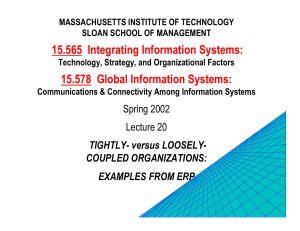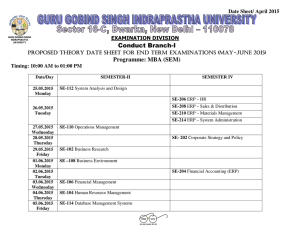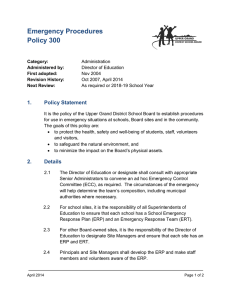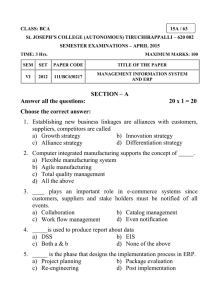TABLE OF CONTENTS CHAPTER TITLE
advertisement
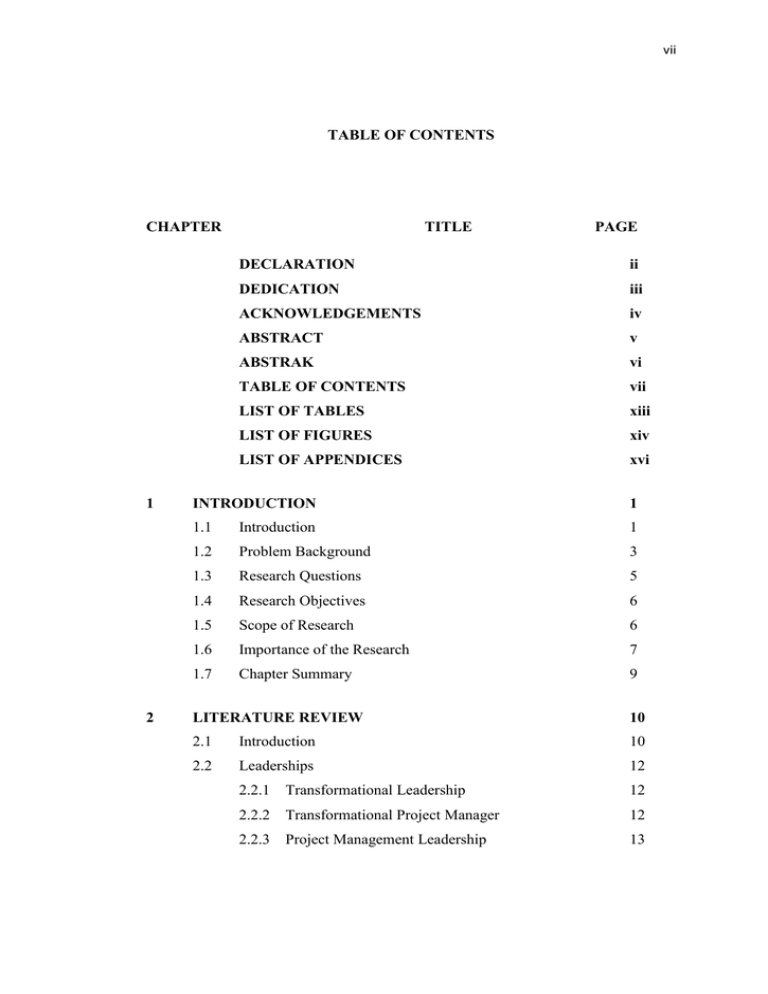
vii TABLE OF CONTENTS CHAPTER 1 2 TITLE PAGE DECLARATION ii DEDICATION iii ACKNOWLEDGEMENTS iv ABSTRACT v ABSTRAK vi TABLE OF CONTENTS vii LIST OF TABLES xiii LIST OF FIGURES xiv LIST OF APPENDICES xvi INTRODUCTION 1 1.1 Introduction 1 1.2 Problem Background 3 1.3 Research Questions 5 1.4 Research Objectives 6 1.5 Scope of Research 6 1.6 Importance of the Research 7 1.7 Chapter Summary 9 LITERATURE REVIEW 10 2.1 Introduction 10 2.2 Leaderships 12 2.2.1 Transformational Leadership 12 2.2.2 Transformational Project Manager 12 2.2.3 Project Management Leadership 13 viii 2.3 2.4 Critical Success Factors of ERP Implementation 14 2.3.1 Executive Management Support 15 2.3.2 Project Champion or Sponsor 15 2.3.3 Project Management 15 2.3.4 Steering Committee 16 2.3.5 Engagement of Independent ERP Consultants 16 2.3.6 Business Process Engineering (BPR) 16 2.3.7 ERP Vendor Selection 17 2.3.8 Effective Communication 17 2.3.9 Change Management 17 2.3.10 Risk Management 18 2.3.11 Use of Vendor’s Development and Acceleration Tools 18 2.3.12 Project Team Composition and Competencies 19 2.3.13 ERP Vendor and Customer Partnership 19 2.3.14 User Involvement 19 2.3.15 Team and Users Training and Education 20 2.3.16 Clear Understanding of Strategic Goals and Objectives 20 2.3.17 Managing Expectations 20 2.3.18 Minimal Customization 21 2.3.19 Dedicated Resources 21 2.3.20 Technological Infrastructure 22 2.3.21 Data Analysis and Conversion 22 Critical Failure Factors of ERP Implementation 22 2.4.1 Poor Top Executive Support and Commitment 23 2.4.2 Poor Project Management Effectiveness 23 2.4.3 Poor Change Management 23 2.4.4 Poor Consultant Effectiveness 23 2.4.5 Poor Quality Business Process Reengineering 24 2.4.6 Unrealistic Expectations from Top Executive 24 2.4.7 ERP Software Misfit 24 2.4.8 Poor Communication 24 ix 2.4.9 25 2.4.10 Unclear Requirements 25 2.4.11 Poor Data Conversion and Integration 25 2.4.12 Poor IT Infrastructure 26 2.4.13 Team Member’s High Turnover 26 2.4.14 Poor Training and Education 26 2.4.15 Unrealistic Schedule Estimates 27 2.4.16 Unrealistic Budget Estimates 27 2.4.17 Users’ Resistance to Change 27 2.4.18 Poor Quality Tests 27 2.5 Business Process Reengineering (BPR) 28 2.6 ERP Implementation Methodology 29 2.6.1 Big Bang 29 2.6.2 Phased Rollout 30 2.7 PMI Project Management Body of Knowledge 31 2.8 Project Management Methodology 33 2.8.1 2.9 PRINCE2 (Projects IN Controlled Environments) 34 2.8.2 Goal Direct Project Management (GDPM) 36 2.8.3 Method123 Project Management Methodology (MPMM) 38 Project Management Approach to ERP Implementation 42 2.9.1 Initiating – Project Preparation 43 2.9.2 Planning – Business Blueprinting 43 2.9.3 Executing – Realization 44 2.9.4 Monitoring and Controlling – Final Preparation 45 Closing – Go Live and Support 46 2.9.5 2.10 3 Over-reliance on Extensive Customization Chapter Summary 47 RESEARCH METHODOLOGY 48 3.1 Introduction 48 3.2 Research Methods and Methodology 48 x 4 3.2.1 Research Method 48 3.2.2 Research Methodology 49 3.3 Design of Operational Framework 49 3.4 Method of Data Collection 54 3.4.1 Secondary Data Collection 54 3.4.2 Primary Data Collection 55 3.5 Sources of Information 55 3.6 Tools for Data Collection 55 3.7 Data Analysis 56 3.8 Chapter Summary 58 RESEARCH MODEL AND HYPOTHESES DEVELOPMENT 59 4.1 Introduction 59 4.2 Leadership Core Competencies of a Transformational Project Manager 59 4.3 Hypotheses Formulation 61 4.4 Hypotheses Development 64 4.4.1 4.4.2 4.4.3 4.4.4 4.4.5 4.4.6 4.4.7 4.4.8 4.4.9 Strategic Coordination of Top Executive’s Support and Commitment 64 Deep Knowledge of Organization’s Business Practice and Strategic Direction 64 Development and Managing Effective ERP Implementation Project Team 65 Coordinating Appropriate ERP Training and Education for the Organization 65 Application of Effective and Strategic Change Management Process 66 Enforcement of Effective and Strategic Change Management Process 66 Building and Managing Effective Project Teamwork 67 Empowerment of ERP Implementation Team to Make Decisions 67 Creating Motivation and Satisfaction among Team Members 68 4.4.10 Application of Dynamic Project Management xi Strategies and Methodologies 4.5 5 Chapter Summary 68 70 DATA COLLECTION, ANALYSIS, AND RESULTS 71 5.1 Introduction 71 5.2 Research Instrument 72 5.3 Research Sample 72 5.4 Data Collection 73 5.5 Initial Findings from the Questionnaire 74 5.6 Demographic Findings 75 5.7 Hypotheses Findings 77 5.7.1 5.7.2 5.7.3 5.7.4 5.7.5 5.7.6 5.7.7 5.7.8 5.7.9 5.8 5.9 Strategic Coordination of Top Executive’s Support and Commitment 77 Deep Knowledge of Organization’s Business Practice and Strategic Direction 78 Development and Managing Effective ERP Implementation Project Team 79 Coordinating Appropriate ERP Training and Education for the Organization 80 Application of Effective and Strategic Risk Management Process 81 Enforcement of Effective and Strategic Change Management Process 82 Building and Managing Effective Project Teamwork 83 Empowerment of ERP Implementation Team To Make Decisions 84 Creating Motivation and Satisfaction among Team Members 85 5.7.10 Application of Dynamic Project Management Strategies and Methodologies 86 PLS (Partial Least Square) Path Modelling 87 5.8.1 Reflection Measurement Model 87 5.8.2 Structural Model 88 Statistical Analysis 88 5.9.1 89 Bootstrapping xii 5.9.2 5.10 5.11 6 PLS Algorithm 89 Results 91 5.10.1 Path Coefficients 91 5.10.2 Composite Reliability, AVE, R Square, and Cronbach’s Alpha 93 5.10.3 Latent Variable Correlation 95 5.10.4 Cross Loading 95 Chapter Summary 99 CONCLUSION AND FUTURE WORK 100 6.1 Introduction 100 6.2 Research Contributions 100 6.2.1 Theoretical Implications 102 6.2.2 Practical Implications 102 6.3 Conclusions 103 6.4 Limitations and Recommendations for Future Work 108 REFERENCES Appendices A - C 110 116 - 131 xiii LIST OF TABLES TABLE NO. TITLE PAGE 2.1 Overview of Goal Directed Project Management 38 3.1 Description of Operational Framework 52 4.1 Leadership core competence qualities reference 69 5.1 Hypotheses abbreviations 91 5.2 Path coefficients 93 5.3 Composite reliability, AVE, R Square, and Cronbach’s alpha 94 5.4 Latent variable correlation 95 5.5 Cross Loading 96 5.6 Hypotheses testing 97 5.7 Summary of Hypotheses testing 98 xiv LIST OF FIGURES FIGURE NO. TITLE PAGE 1.1 Research Strategy Diagram (RSD) 8 2.1 Literature Map Diagram (LMD) 11 2.2 Prince2 processes 35 2.3 People System Organization (PSO) project 37 2.4 MPMM project management lifecycle 40 2.5 Six steps of MPMM initiation phase 40 2.6 Ten steps of MPMM planning phase 41 2.7 Three steps and nine management task of MPMM executive Phase 41 2.8 Two steps of MPMM closure phase 42 3.1 Operational Framework 51 4.1 Leadership core competence model of an ERP Implementation project 60 5.1 Years of ERP working experience 75 5.2 Types of respondents 75 5.3 Type of ERP modules used by respondents 76 5.4 Size of employees in respondents’ organizations 76 5.5 Strategic coordination of top executive’s support and commitment 78 Deep knowledge of organization’s business practice and strategic direction 79 Development and managing effective ERP implementation project team 80 Coordinating appropriate ERP training and education for the organization 81 Application of effective and strategic change eanagement process 82 5.6 5.7 5.8 5.9 5.10 Enforcement of effective and strategic change xv management process 83 5.11 Building and managing effective project teamwork 84 5.12 Empowerment of ERP implementation team to make decisions 85 Creating motivation and satisfaction among team members 86 Application of dynamic project management strategies and methodologies 87 5.15 Bootstrapping computation 89 5.16 PLS algorithm computation 90 5.13 5.14 xvi LIST OF APPENDICES APPENDIX TITLE PAGE A Research Questionnaire 116 B PACIS2013 Acceptance Letter 123 C PACIS2013 Accepted Paper 124

